
Asperti A.Categories,types,and structures.1991
.pdf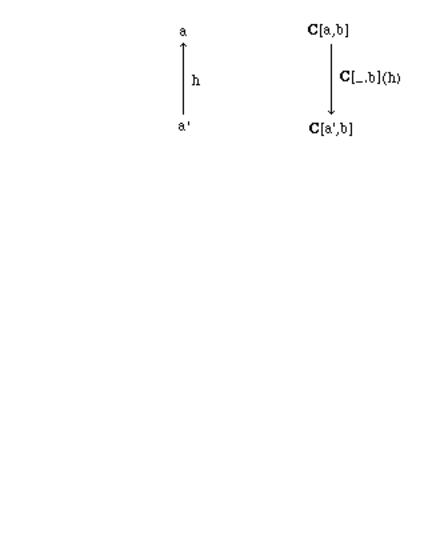
3. Functors and Natural Transformations
category, it is possible to define some functors from C to Set, called hom-functors, that play a central role in the developments of Category Theory. We shall see later that most of this work may be done at a more abstract level, taking an arbitrary topos D instead of Set.
3.1.5 Definition Let C be a locally small category. Given a ObC, the covariant hom-functor C[a,_]: C→Set is given by:
i.for every b ObC C[a,_](b) = C[a,b] ObSet;
ii.for every g C[b,b'], C[a,_](g): C[a,b]→C[a,b'] is the function that takes f C[a,b] to (g°f)
C[a,b'] that is,
The function C[a,_](g) will be denoted in the sequel by “C[a,g]” or also by the suggestive “g ° _” (some authors use also g*). Note that the drawing above is clearly an implication between diagrams. Their plain juxtaposition will be used often in the sequel with this meaning, as a special case of the “conditional equational reasoning” mentioned earlier in section 1.2.
3.1.6 Definition Let C be a locally small category. Given b ObC , the contravariant homfunctor C[_,b]: C→Set is given by:
i. for every a ObC C[_,b](a) = C[a,b] ObSet
ii. for every h C[a',a], C[_,b](h): C[a,b]→C[a',b] is the function that takes f C[a,b] to f ° h C[a',b] that is
The function C[_,b](h) will be denoted in the sequel by “C[h,b]” or by the suggestive “_ ° h” (some authors use also h* .)
3.1.7 Definition Let C be a locally small category. Given b ObC , the hom-functor C[_,_]: CopxC→Set is given by:
44
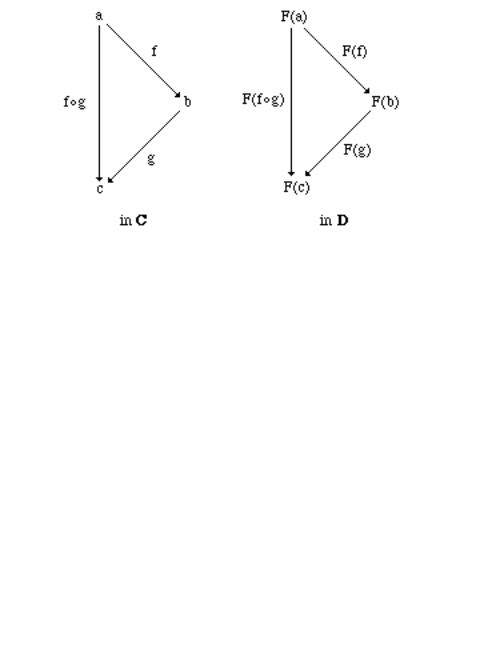
3.Functors and Natural Transformations
i.for every (a,b) ObCxC C[_,_](a,b) = C[a,b] ObSet
ii.for every h C[a',a], g C[b,b'], C[_,_](h,g): C[a,b]→C[a',b'] is the function that takes f C[a,b] to g ° f ° h C[a',b']
C[_,_] is contravariant in the first argument and covariant in the second. One may understand how C[_,_] works on morphisms by the following commutative diagram:
The function C[_,_](h,k) will be denoted by “C[h,k]” or by “g °_ ° h.”
Exercise: prove in details that C[a,_] and C[_,b] are a covariant and a contravariant functor,
respectively.
Exercise A category C has enough points iff the functor C[t, -] is faithful, when t is terminal.
3.2 Natural Transformations
The fact that F is a functor from a category C to a category D may be equivalently expressed by F(id) = id and, for every f and g in MorC , by the following (implication between) diagrams:
Consider now two functors F, G: C→ D. A quite reasonable idea of transformation from F to G is a “translation” as described in the following picture, where the dotted lines should yield commutative squares
45
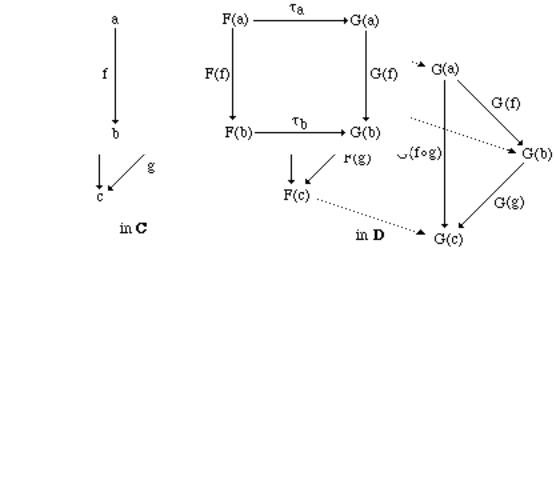
3. Functors and Natural Transformations
Thus, the “translation” can be defined by assigning to each object a ObC an arrow τa: F(a)→G(a), with the only condition that, for every f C[a,b], the following diagram commutes:
The properties described in this diagram are equivalently formalized by the following definition.
3.2.1 Definition. |
Let |
F,G : C → D be functors. Then τ : F → G is a n a t u r a l |
transformation from |
F to |
G iff: |
i.a ObC τa D[F(a),G(a)]
ii.f C[a,b] τb ° F(f) = G(f) ° τa .
3.2.2 Example Let C be a small |
category, and h C [a',a] . The collection (in |
Set) of |
morphisms {C[h,b] / C[a,b]→C[a',b] }b C, defines a natural transformation C[h,_] |
from the |
|
(contravariant) hom-functor C[a,_] to |
the (contravariant) hom-functor C[a',_]. Note the following |
|
diagram: |
|
|
46
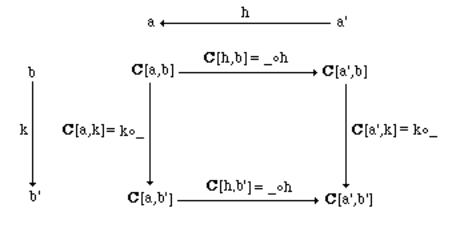
3. Functors and Natural Transformations
The same diagram proves that, given k C[b,b'], the collection of morphisms {C[a,k] / C[a,b]→C[a,b'] }a C defines a natural transformation C[_,k] from the hom-functor C[_,b] to the hom-functor C[_,b'].
It is easy to close up natural transformations under composition by setting (τ˚β)a = (τa)˚(βa). This composition of natural transformation is usually called vertical, as opposed to the horizontal composition, defined at the end of this section. Since the identity transformation from a functor F to itself is defined in the obvious way, we have actually constructed a new category, starting from any two given categories C and D .
The new category is called the category of functors from C to D, (C→D) = Funct(C,D); its objects are functors and the morphisms are natural transformations. In particular, if F,G: C→D,
Funct(C,D)[F,G] is the collection of all the natural transformations from F to G; in the following we shall use the abbreviation Nat(F,G) instead of Funct(C,D)[F,G].
Two functors from C to D are equivalent (or naturally isomorphic) iff they are isomorphic
as objects of Funct(C,D). For example, it is well understood that any set A is isomorphic to A×1, where 1 is a singleton. For arbitrary cartesian categories, this corresponds to saying that the functor _×1 and the identity functor Id are naturally isomorphic. If F: C→D is a full embedding, then C is isomorphic to a full subcategory of D. The next section will present further examples of natural isomorphisms.
The concept of natural isomorphism of functors also allows us to define a notion of “equivalence” between categories, which captures better than the notion of isomorphism the sense that two categories can be said to be “essentially the same.” Two categories C and D are equivalent if and only if there are two functors F: C→D and G : D→C such that G ° F idC and F ° G idD (note that C is isomorphic to D iff G ° F = idC and F ° G = idD).
3.2.3 Proposition Let F,G : C→D be functors and τ : F→G F to G. Assume that, for each a ObC, τa D[F(a),G(a)] natural isomorphism.
be a natural transformation from is an isomorphism. Then τ is a
47

3. Functors and Natural Transformations
Proof Define τ-1 : G→F by τ-1a = (τa)-1. τ-1 is natural, since f C[a,b] τ−1b ° G(f) = τb−1 ° G(f) ° τa ° τa-1
=τb−1 ° τb ° F(f) ° τa-1
=G(f) ° τ−1a. ♦
Examples A simple example of natural transformation may be given by studying “liftings” (see section 2.6), in various categories. One may actually understand the general notion better, by completing a little exercise on natural transformations. Indeed, what is hidden behind definition 2.6.2, is the “naturality” of τc. When writing this down explicitly, the definition is tidier and more expressive. Let C be a Category of partial maps, Ct be the associated category of total maps, and Inc: Ct→C be the obvious inclusion. Thus, 2.6.2 may be simply restated as
The lifting of a ObC is the object a° such that the functors C[_,a] ° Inc, Ct[_,a°] : Ct→Set are naturally isomorphic.
Then, by definition of natural transformation and hom-functor, this requires the existence of a function τ such that the following diagram commutes, for any object b and c in C and f Ct[c,b]
That is, τc(g°f) = τb(g)°f and (τc)-1(h°f) = (τb)-1(h)°f , for any total f, since τ is an isomorphism. With this definition, to prove unicity of liftings is even smoother than in section 2.5. Indeed, let
τ be the given natural isomorphism, and let a' and β |
be an alternative lifting and natural |
|
isomorphism. Set |
φ = τ ° β-1. Then Ct[_,a'] and Ct[_,a°] |
are naturally isomorphic via φ and, for |
f = φa'(id): a'→a° |
and g = ( φa° )-1(id): a°→a', one has: |
|
|
g°f = ( φa° )-1(id)°f |
|
|
= ( φa' )-1(id°f) |
by naturality |
|
= ( φa' )-1( φa'(id) ) |
|
= id.
Similarly for f°g = id (on a°).
Since we are now familiar with functors, we may look also at lifting as a functor.
48
3. Functors and Natural Transformations
Let C be a pC and assume that for each a ObC there exists the lifting a°. Then there is a (unique) extension of the map a |_ a° to a functor _° : C→Ct (the lifting functor).
The reader may check this as an exercise (hint: observe that exa = ( τa°)-1(id): a˚→a and use the naturality of τ ) .
As for specific examples, the lifting functor for pSet is obvious. It can be easily guessed also for the category pPo of p.o.sets and partial monotone functions with upward closed domains: just add a fresh least element and the rest is easy for the reader who has completed the last exercise. Note, and it is crucial, that by monotonicity the lifting functor does not exist if one doesn't assume that the
domains are upward closed.
The category pCPO is given by defining complete partial orders under the assumption that directed sets are not empty. Thus, the objects of pCPO do not need to have a bottom element. As for morphisms, take the partial continuous functions with open subsets as domains. Clearly, the
lifting functor is defined as it is for pPo.
A more complex example is given by EN, the category of numbered sets in section 2.2. Let pEN be the partial category of numbered sets in the example before 2.5.2. Given a = (a,e) ObpEN,
define a° = (a°,e°) by adding a new element |
to the set a and by defining |
e°(n) = if φn(0) |
||||||||||||
converges then e(φn(0)) else |
. Clearly, e° : ω→a° is surjective. Let now |
b = (b,e') and |
||||||||||||
f pEN[b, |
a]. By definition, there exists f' PR |
such that f°e' =e°f'. We define the extension |
||||||||||||
f EN[b, |
a°] of |
f by giving f' R |
which represents f . That is, set φf'(n)(0) = f(n). Such an f' R |
|||||||||||
|
|
|
|
|
|
|||||||||
exists by the s-m-n (iteration) theorem. Thus, |
|
|
|
|
||||||||||
|
|
|
|
|
f(e'(n)) = e°(f'(n)) |
|
|
|
|
|||||
|
|
|
|
|
|
|
= if φf'(n)(0) converges then e( φf'(n)(0)) |
else |
. |
|
||||
Therefore, if |
f(e'(n)) = e(f'(n)) |
is defined, then φf'(n)(0) converges |
and, |
hence, f(e'(n)) = |
||||||||||
e(φf'(n)(0)) = |
f(e'(n)). Finally, |
set τab(f) = f |
. For each a, τa gives the required natural |
|||||||||||
isomorphism, |
as g EN[b, |
a°] !f pEN[b,a] |
f'(n) = φg'(n)(0). (Exercise: check the due |
|||||||||||
|
|
|
|
|
||||||||||
diagram). By the fact above, this defines the lifting functor in pEN.
Exercise Define the category ER of equivalence relations on ω and effective maps (hint: the objects are quotient sets on ω, and the morphisms are induced by total recursive functions similarly as for EN). Observe that ER and EN are equivalent, but not isomorphic. Indeed, one is small, while the other is not.
We next discuss ways to derive natural transformations from a given one and, finally, the notion of horizontal composition.
Let H: A→B, F: B→C, G: B→C, K: C→D be functors, and let τ: F→G be a natural transformation as shown in the following diagram:
49

3. Functors and Natural Transformations
τ induces two natural transformations Kτ: KF→KG, and τH: FH→GH, respectively defined by (Kτ)b = K(τb) : KF(b)→KG(b);
(τΗ)a = τH(a) : FH(a)→GH(a) We have, for every f B[b,b'] and every g A[a,a'],
(Kτ)b'° KF(f) = K(τb) ° K(F(f)) = K(τb° F(f) ) = K(G(f) ° τb) = KG(f) ° Kτb = KG(f) ° (Kτ)b (τH)a'° FH(g) = τH(a') ° F(H(g)) = G(H(g)) ° τH(a) = GH(g) ° (τH)a
that proves the naturality of Kτ and τH .
Consider now categories, functors, and natural transformations as described in the following diagram:
Then, for the naturality of σ with respect to the arrow τb, the following diagram (in D ) commutes for every b ObB:
50
3. Functors and Natural Transformations
The horizontal composition of σ and τ is the natural trasformation στ: HF→ΚG defined by,
for every b ObB, στb = σG(b) ° H(τb) = K(τb) ° σF(b). |
|
We check the naturality of στ . Let f B[b,b'] , then |
|
στb' ° HF(f) = σG(b') ° H(τb') ° HF(f) |
|
= σG(b') ° H(τb' ° F(f) ) |
|
= σG(b) ° H( G(f) ° τb ) |
by the naturality of τ |
= σG(b) ° H( G(f) ° τb ) |
by the diagram |
= Κ(G(f) ° τb) ° σF(b) |
|
= ΚG(f) ° K(τb) ° σF(b) |
|
= ΚG(f) ° στb |
|
Note that if we identify the functors K and H with the identity natural transformation idK and idH, Kτ and τH may be understood as particular cases of the horizontal application between natural transformations (why?).
Exercise Prove the following equality among natural transformations (interchange law): (ν ° µ)(τ ° σ) = (ντ) ° ( µσ) .
3.3 Cartesian and Cartesian Closed Categories Revisited
By definition, a category C is Cartesian iff it contains a terminal object t , and for every a,b ObC there is an object a×b together with two morphisms p1: a×b→a , p2: a×b→b, and for every object c an isomorphism < , >c : C[c,a]×C[c,b]→C[c,a×b] such that for all morphisms f: c→a, g: c→b, h: c→a×b, the following equations hold:
i.p1 ° <f,g>c = f
ii.p2 ° <f,g>c = g
We want now to show that < , >c |
is also “natural in c”, i.e. it satisfies the property: |
|
(nat) for every |
k: c→c' <f,g>c' ° k = <f ° k, g ° k >c |
|
Indeed, we have <f,g>c' ° k = <p1 ° <f,g>c' ° k, p2 ° <f,g>c' ° k >c |
by ii) |
|
= < f ° k, g ° k >c |
by i) |
|
The previous “naturality” property suggests that < , > is actually a natural isomorphism. Indeed, let
∆: C→C×C the functor defined by ∆(c) = (c,c), ∆(f) = (f,f) |
(∆ is called the diagonal functor); |
|
then < , > is a natural isomorphism from C×C[_,(a,b)] ° ∆ to |
C[_,a×b]. Note that C×C[_,(a,b)] ° |
|
∆ and |
C[_,a×b]: C→Set are contravariant functors. Conversely suppose to have for all objects a |
|
and b |
an object a×b and a natural isomorphism τ : C×C[_,(a,b)] ° ∆ C[_,a×b]. The naturality |
|
of τ-1 |
is expressed by the following commutative diagram: |
|
51
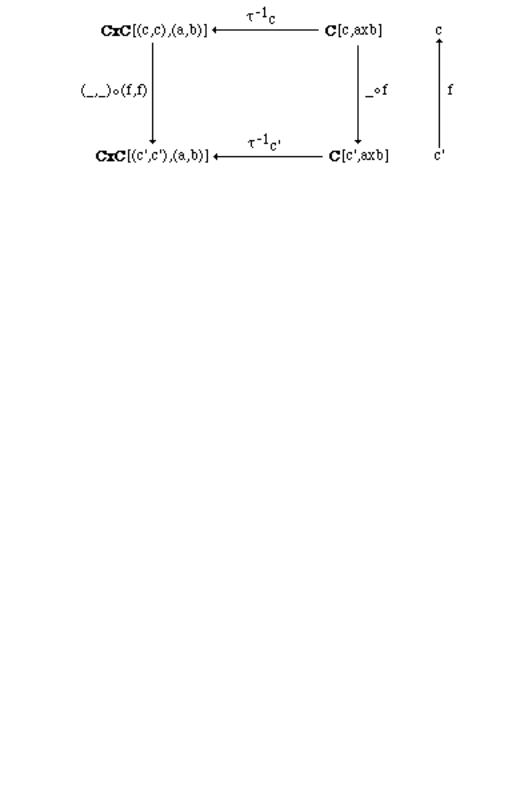
3. Functors and Natural Transformations
Let |
(q ,q |
2 |
) = τ-1 |
a×b |
(id |
|
|
) . Note that |
q : a×b→a, q : a×b→b . We want to prove that |
a×b is a |
||||||||||||||
|
1 |
|
|
|
|
|
|
a×b |
|
|
1 |
|
2 |
|
|
|
|
|||||||
product with projections q1 |
and q2. Indeed, let |
f = τc(h,g): c→a×b |
in the above diagram, then we |
|||||||||||||||||||||
have (q |
1 |
,q |
2 |
) |
° |
( τ |
c |
(h,g), τ |
c |
(h,g) ) = τ-1 |
c |
(id |
a×b |
° |
τ (h,g) ) = (h,g) and, in particular, q |
τ |
c |
(h,g) = |
||||||
|
|
|
|
|
|
|
|
|
|
|
|
c |
1 ° |
|
|
|||||||||
h ; |
q2 ° τc(h,g) = g . |
|
|
|
|
|
|
|
|
|
|
|
|
|
||||||||||
|
The previous considerations suggest another characterization of Cartesian Category: |
|
|
|
||||||||||||||||||||
3.3.1 Proposition A category C is Cartesian iff it contains a terminal object t, and for every a,b ObC there is an object a×b and a natural isomorphism < , > : C×C[_,(a,b)] ° ∆ → C[_,a×b].
The situation is quite similar, and perhaps even simpler, in the case of exponents. Remember that a category C is a CCC iff it is Cartesian and has exponents for every pair of objects, i.e. for every a and b in C there is an object ba together with a morphism evala,b: ba×a→b (evaluation map) and, for every object c , a function Λc : C[c×a,b]→C[c,ba] such that, for all morphisms f: c×a→b, h: c→ba, one has
β. evala,b ° (Λ(f)×ida) = f η. Λ(eval°(h×id)) = h
It turns out that Λc is “natural in c”, in the sense that for any f C[c×a,b], g C[d,c] Λc'(f) ° g = Λc(f ° g×id) ,
In order to check this, recall that (β) corresponds to:
Thus, by twice (Diag.Eval), the following diagram commutes
52
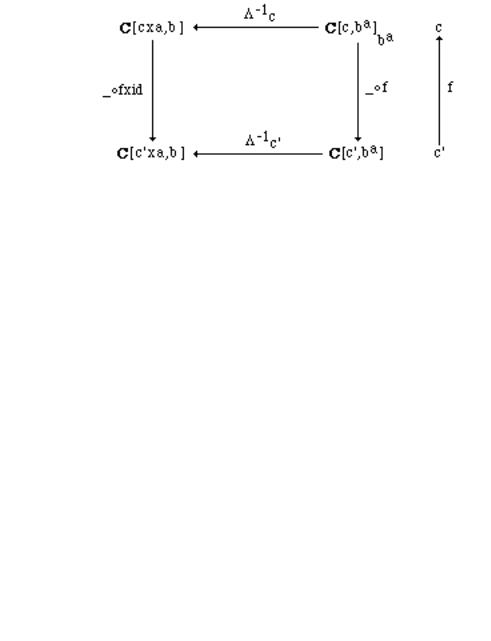
3. Functors and Natural Transformations
Moreover, set Λ-1 = eval (_×id). |
|
|
|
° |
|
Then |
Λ-1 Λ = id |
by (β) |
|
° |
|
and |
Λ Λ-1 = id |
by (η). |
|
° |
|
That is, for each |
c ObC, Λc: C[c×a,b]→C[c,ba] is an isomorphism. Thus Λ is a natural |
|
isomorphism, by proposition 3.2.3.
Note that, formally, Λ is a natural transformation from the contravariant functor C[_,b] ° _×a to the contravariant functor C[_,ba] (where _×a is the product functor defined in the obvious way). We abbreviate C[_,b] ° _×a as C[_×a,b]. Note also that C[_×a,b], C[_,ba]: C→Set.
Conversely, suppose that, for all objects a and b, there is an object ba and a natural isomorphism Λ: C[_×a,b] C[_,ba]. Then the naturality of Λ -1 is expressed by the following commutative diagram:
Set now evala,b = Λ-1ba (idba) and note that evala,b: ba×a→b . We want to prove that ba is an exponent with evala,b as evaluation map . Indeed, let f = Λc(g): c→ba in the above diagram. Then
we have:
evala,b ° ( Λc(g)×id ) = Λ-1c(idba ° Λc(g) ) = g This argument gives the following equivalent characterization of CCC:
3.3.2 Proposition C is a Cartesian closed category iff it is Cartesian and for every a,b ObC there is an object ba and a natural isomorphism Λ : C[_×a,b] → C[_,ba] .
53
